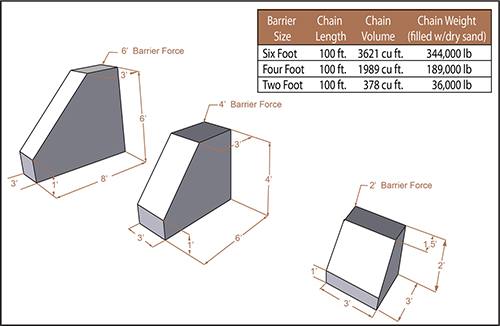Yes! As long as the delivery system will stand up on the bottom and can be advanced. Fill material must be able to reach the system via conveyors, dredge, excavator, concrete pump, etc. The system will install Barrier Force protective barriers in moving water up to half the height of the cells. Rates exceeding 4 feet per second have not been tested.
The Barrier Force Difference

How different can a sandbag truly be?
Unlike traditional sandbags, Barrier Force™ protective barriers are a series of pentagon-shaped bags sloped on one side, vertical on the other, open at the top, and connected side by side like an accordion. Self-contained cells allow the barrier to be unaffected if one cell breaks, remaining strong and standing. These temporary or permanent cellular structures are designed to protect against natural disasters while remaining simple to use and reducing the usual costs of building a temporary or semi-permanent flood-defense barrier.
Barrier Force™ installation is simple: Workers install the bag segments on a Man Portable Deployment Unit (MPDU) and fill them with dirt, sand, or other recommended material. Using an excavator on tracks or a front-end loader, workers fill each cell using on-site fill material, and the MPDUs are removed immediately after filling is complete and leapfrogged ahead to the next set of cells. In a ten-hour day, a four-person team with one skid steer can install a 1,000-foot barrier. This process is considerably less labor-intensive and cost-intensive than using traditional sandbags.
The cells are made of high-strength textile. Once the bags have been used, they can be recycled, but Barrier Force™ materials also have UV protectants, allowing them to last for years, depending on the intensity of the sunlight.
Barrier Force™ barriers may be used to ensure flood and mudslide protection, to build earthquake-safe walls, and to provide safety and water-control barriers and gravity walls.
So how different can a sandbag truly be?
Very.


